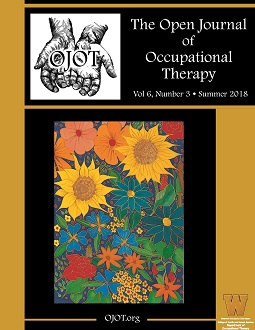ScholarWorks > HHS > OT > OJOT > Vol. 6 > Iss. 3 (2018)
Volume 6, Issue 3 (2018) Summer 2018
Technology in Occupational Therapy and Occupational Science: Evidence, Education, and Impact.
This special section highlights research on contemporary applications of technology in occupational therapy practice and aims to challenge current perspectives on the impact of technology in daily occupational participation. Guest Editors Dr. Lenin Grajo and Dr. Angela Boisselle propose the use of an occupational justice paradigm when evaluating, using, and measuring the outcomes of technology in clinical practice. In their They Said article, a panel of international assistive technology experts present a global perspective to challenge and broaden Western notions of technology use and access.Letter from the Editor
Infusing an Occupational Justice Perspective to Technology use in Occupational Therapy Practice
Lenin C. Grajo and Angela K. Boisselle
Special Section: Technology
They Said: A Global Perspective on Access to Assistive Technology
Angela K. Boisselle and Lenin C. Grajo
Perceptions of Older Adults on the Use of an Interactive Video Game in Promoting Health and Well-Being
Maria Cruz, Julie D. Kugel, Liane Hewitt, and Arezou Salamat
The Impact of Online Video Cases on Clinical Reasoning in Occupational Therapy Education: A Quantitative Analysis
Lynne F. Murphy and Wendy B. Stav
Applied Research
Journey Interrupted: A Phenomenological Exploration of Miscarriage
Marit A. Watson, Vanessa D. Jewell, and Sarah L. Smith
Women Family Members’ Experiences of Involvement in Adult Inpatient Traumatic Brain Injury Rehabilitation
Isabelle Savage and Mary Egan
Increasing Competency for Parents of Adolescents with Executive Functioning Deficits: Enhancing Occupational Performance with Mindfulness
Kimberly S. Mollo, Bernardo A. Merizalde, and Jennifer E. Lape
Use of Neuromuscular Electrical Stimulation in the Treatment of Neonatal Brachial Plexus Palsy: A Literature Review
Denise Justice, Jonathan Awori, Spencer Carlson, Kate W-C Chang, and Lynda J-S Yang
Levels of Arousal in Positive Moods: Effects on Motor Performance
Carolina Valencia, Krista Currier, Sarah Lindsay, Pamela Lemperis, Titus Hughes, and Jeanne Sowers
How Service Dogs Enhance Veterans’ Occupational Performance in the Home: A Qualitative Perspective
Terry K. Crowe, Mylinh T. Nguyen, Brenda G. Tryon, Stephanie Barger, and Victoria Sanchez
Topics in Education
Sexual Functioning in Occupational Therapy Education: A Survey of Programs
Kate Eglseder, Sheridan Webb, and Miranda Rennie
Development and Evaluation of a Collaborative Model Level II Fieldwork Program
Annmarie T. Kinsella and Catherine V. Piersol
Occupation and the Artist
Overcoming Barriers by Doing Things Differently
Jennifer Fortuna

Editors
- Guest Editor
- Lenin C. Grajo, PhD, EdM, OTR/L
- Guest Editor
- Angela Boisselle, PhD, OTR
- Editor-in-Chief
- Diane Powers Dirette, Ph.D., OTL, FAOTA
- Managing Editor
- Ben J. Atchison, Ph.D., OTR/L, FAOTA
- Associate Editor
- Allison Chamberlain Fox, MS, OTRL
- Copy Editor
- Cynthia J. Cunningham, Ph.D.
- Art Editor
- Jennifer Fortuna, MS, OTR/L You may at ot-ojot@wmich.edu
Occupation and the Artist
The “Occupation and the Artist” section of OJOT highlights the use of art in the practice of OT and in the occupations of both consumers of OT services and its practitioners. Click here to explore this unique feature of OJOT.

